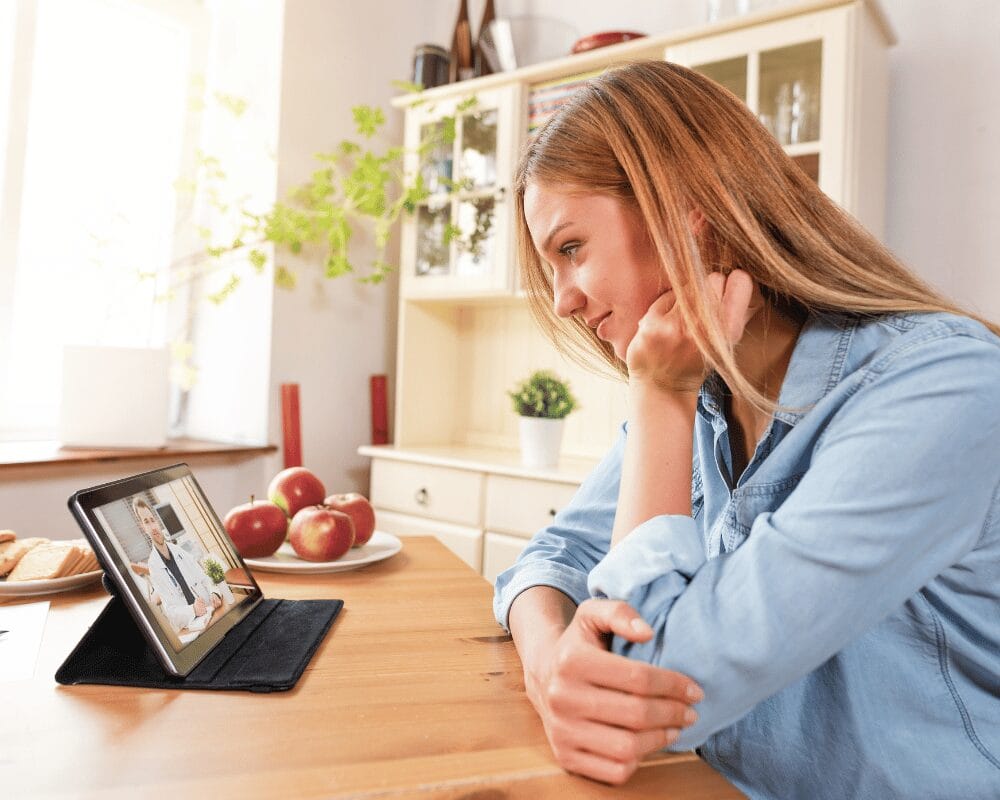One of the few positive things brought about by the COVID-19 pandemic has been the acceptance of telemedicine by both healthcare providers and patients. Telemedicine, or telehealth, is defined as the process of providing healthcare from a distance through technology like videoconferencing, patient portals, and remote monitoring of patients’ vital signs and other data.
Even before the pandemic, clinicians were relying on technology to make healthcare more accessible to patients in remote areas or with disabilities that made in-person visits difficult. A survey of more than 1,200 physicians conducted by physician polling website Sermo in April 2020 showed that more than 90 percent were conducting some of their patient visits via telehealth.
With the onset of the pandemic, the need for remote patient care to diagnose and treat mental health issues like depression and anxiety—which have increased throughout the pandemic—became critical. Telepsychiatry, a subset of telemedicine, offers patients a range of services, from psychiatric evaluations, therapy (individual, group, and family therapy), to patient education, and medication management. Mental healthcare can be delivered via live, interactive consultations between a psychiatrist and a patient, and can support patients’ primary care. Video-based telepsychiatry offers convenient, affordable, and readily accessible mental health services that can benefit patients in a number of ways, including:
- Improved access to mental health specialty care that might not otherwise be available, such as in rural areas
- Bringing care to the patient’s location
- Helping to integrate behavioral healthcare and primary care
- Reducing the need for trips to the emergency room
- Shortening delays in care
- Improving continuity of care and follow-up
- Reducing the need for time off work, childcare services,
- Lessening potential transportation barriers, like lack of transportation or the need for long drives
- Reducing the barrier of stigma that is sometimes linked to mental illness
While telepsychiatry doesn’t allow the patient and practitioner to meet in the same room, it can create a sense of security and privacy for many individuals, and often, patients are better able to open up and speak frankly from the comfort of their own homes. Research has found that telepsychiatry is equivalent to in-patient care in effectiveness, diagnostic accuracy, quality of care, and patient satisfaction, and overall, experiences among all age groups have been positive. And according to the American Psychiatric Association, telepsychiatry has been found to be especially effective in treating post-traumatic stress disorder (PTSD), depression, and attention deficit/hyperactivity disorder (ADHD).
Telepsychiatry is used in a variety of settings, including private practice, clinics, correctional facilities, hospitals, and nursing homes. Especially in senior-care facilities, telepsychiatry is being used to provide both ongoing psychiatric evaluation and care and emergency crisis intervention in cases where it can be difficult to find a qualified, local psychiatrist.
Also, due to pandemic-related lockdown measures, feelings of isolation and depression are widespread. According to data from Mental Health America, screening for anxiety increased 93 percent between January 2020-September 2020, and at the same time, more than one million people who took online screens for depression and anxiety expressed an immediate need for resources and support.
In one of the largest trials of telepsychiatry to date, The Study to Promote Innovation in Rural Integrated Telepsychiatry (SPIRIT), a five-year study published on August 25, 2021 in JAMA Psychiatry, results showed that telepsychiatry in rural, federally qualified health centers was a huge success for patients with bipolar disorder and/or PTSD. Lead researcher Dr. John Fortney, a professor of psychiatry and behavioral sciences at the University of Washington School of Medicine said, “The results of our trial showed that if you give access to high-quality care for patients who are underserved, they improve their quality of life.”
According to the researchers, without telepsychiatry, most of the patients in rural settings would not have received help from a mental health specialist. Fortney added, “We’re at a time now where almost everybody has sort of come to realize what a huge burden untreated mental illness and addiction problems have been.” The trial was funded by the Patient-Centered Outcomes Research Institute.
As the use of telehealth continues into the post-COVID world, telepsychiatry can pave the way to better uses of technology in the healthcare arena. But the technology must be tailored to specific individual needs; there are definite disparities around technology access and proficiency. Older adults frequently prefer tablets to computers or smartphones, and teleconferencing platforms with which they are familiar. In evaluating a patient’s mental health, observing elements such as lighting, household clutter, and organization, can provide context on day-to-day wellbeing.
In addition to telepsychiatry, wearable fitness monitors and smartwatches can track sleep and movement patterns, providing clinicians with insights into a range of psychiatric conditions including depression and anxiety. Newer generations of wearables also offer physiological data like blood pressure and oxygen saturation that, when merged with other information, will generate more facts about the components of mental illness outside the physician’s office or clinic.
The Allure Group, based in New York City, has adopted new technology to provide remote patient monitoring to help care for patients in its six skilled nursing facilities. Its telehealth system provides 24/7 physician-led medical care, so when a resident has an urgent medical need after hours or on a weekend or holiday, a telehealth doctor can guide facility staff via video through a virtual exam. The doctor can order additional lab tests to reach a proper diagnosis without the patient having to go to the emergency room. This telemedicine solution prevents unnecessary ambulance rides, long waits in the ER, and additional expenses. Allure’s ConstantCare technology also allows clinicians to capture and record vital signs which then go directly to a patient’s electronic health record (EHR), a key component to preventing and treating a range of conditions.
Clearly, with an ongoing shortage of healthcare workers, telehealth will continue to grow in 2021, providing greater access to patients of all sorts, but especially the elderly and those with mental health issues who will benefit the most from telepsychiatry.

Joel Landau
Joel Landau, is founder and chairman of The Allure Group, a network of six New York City-based nursing homes.







